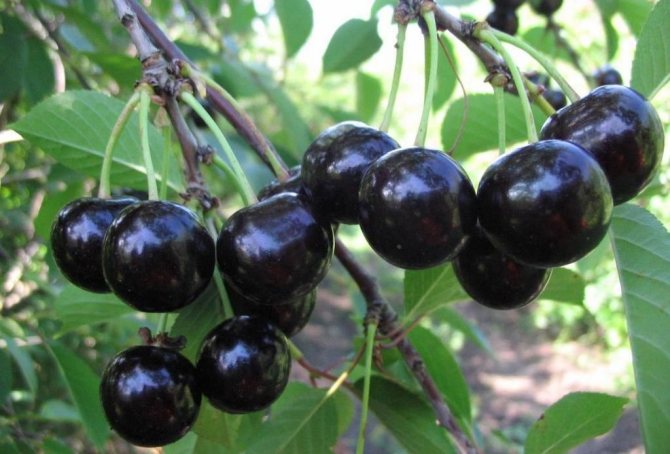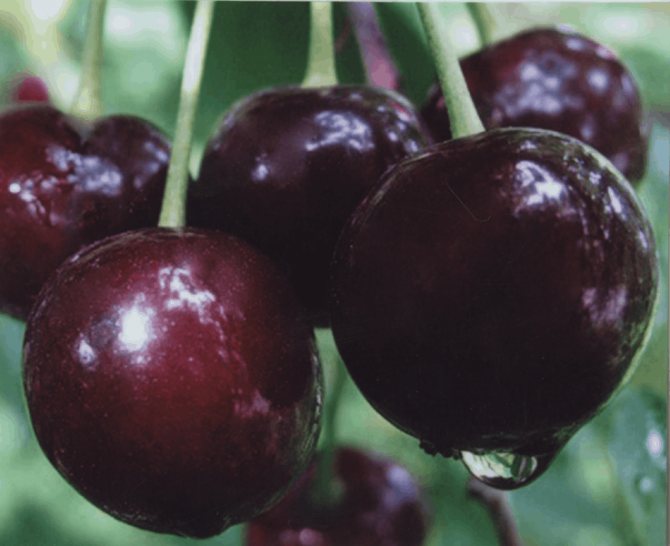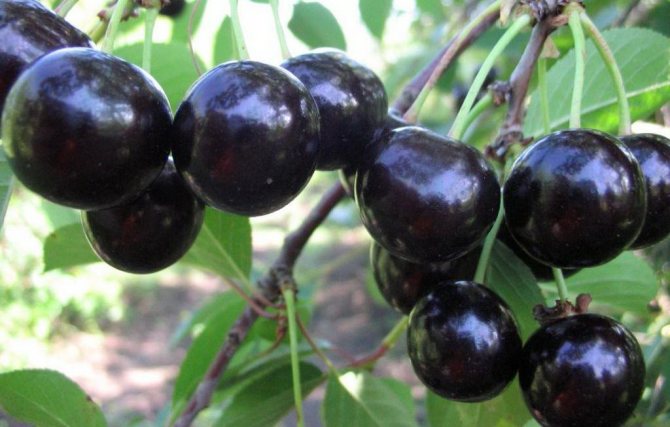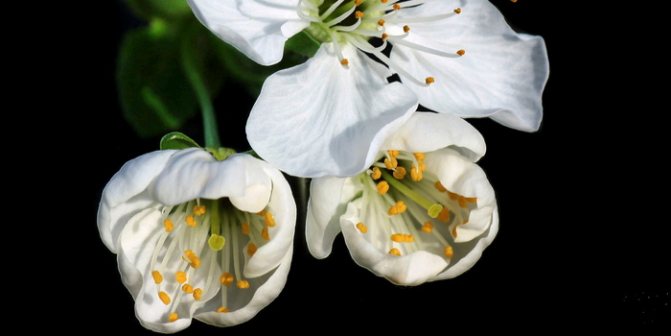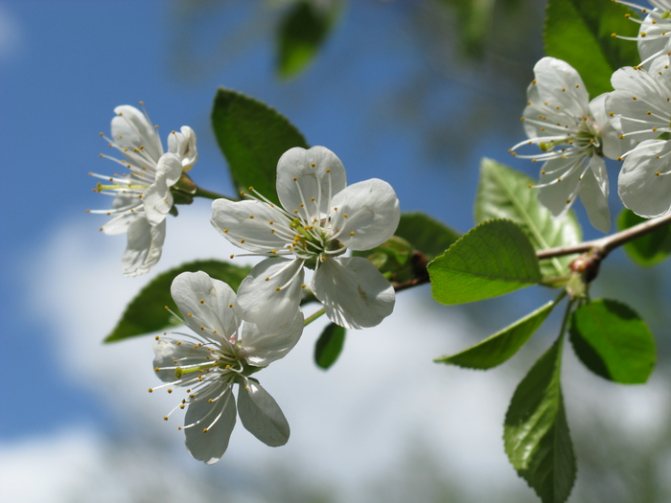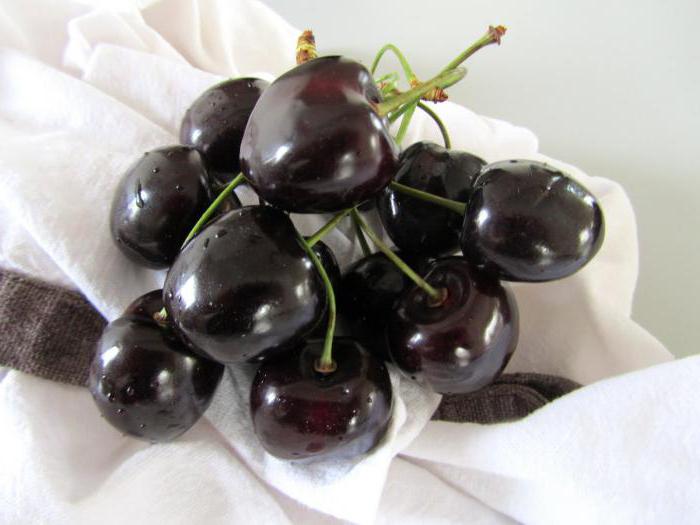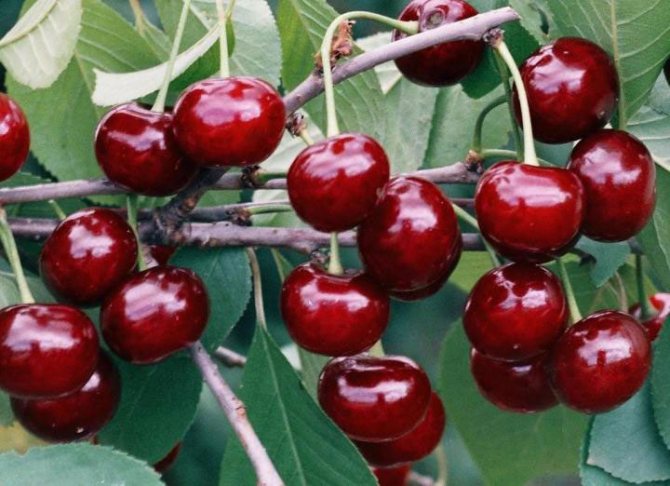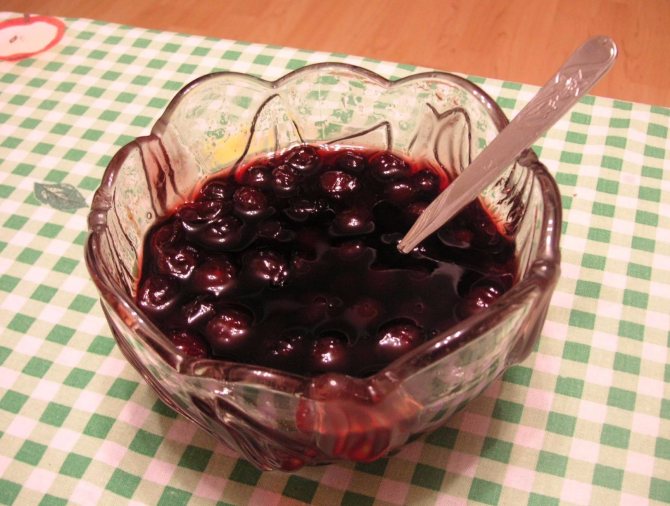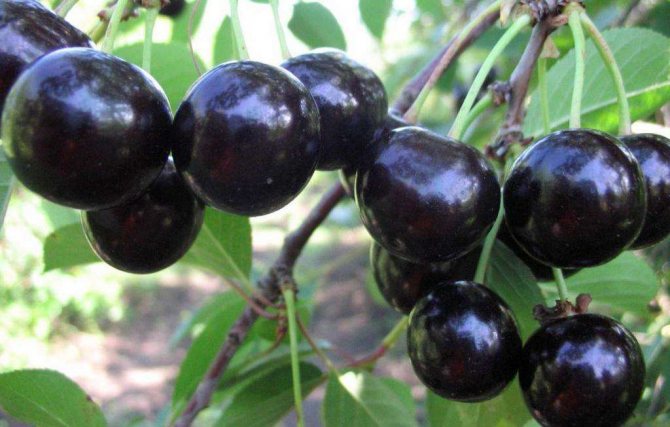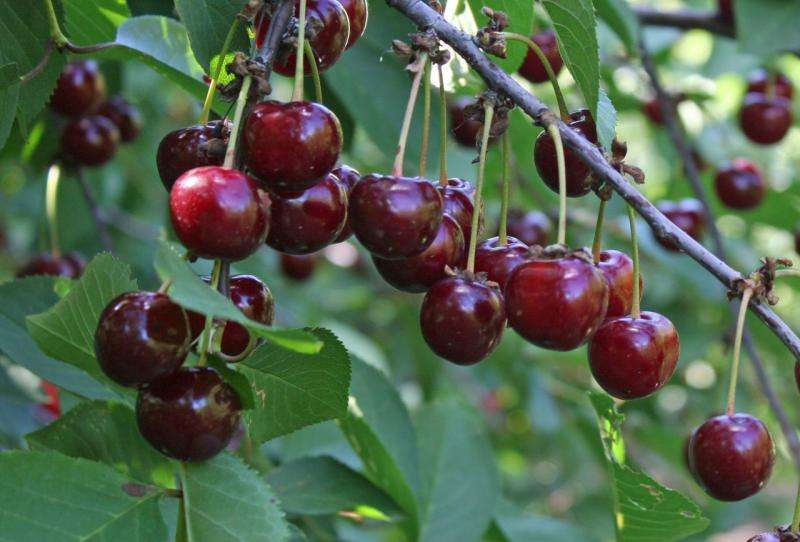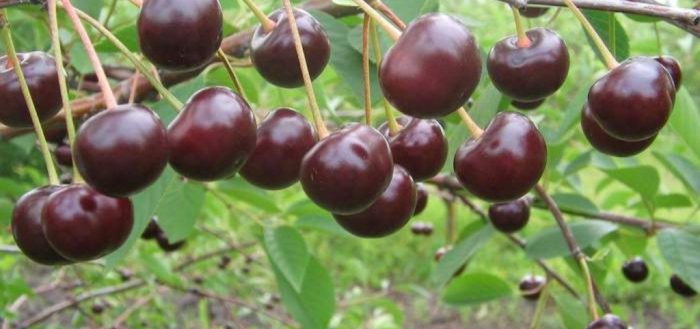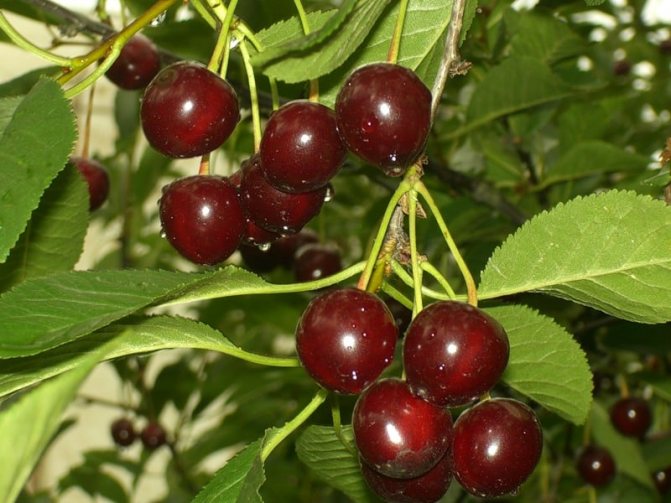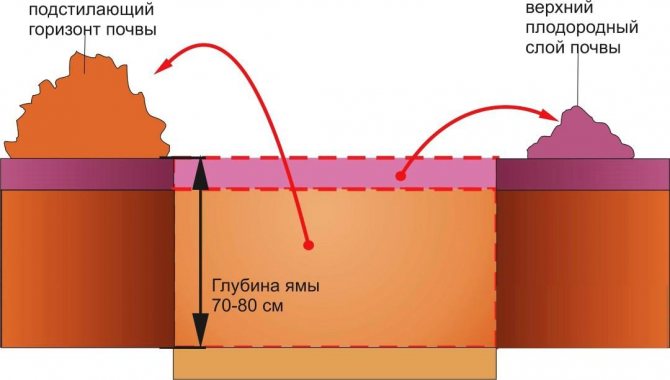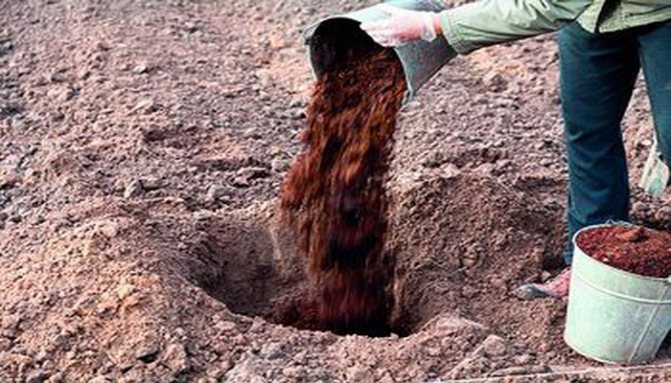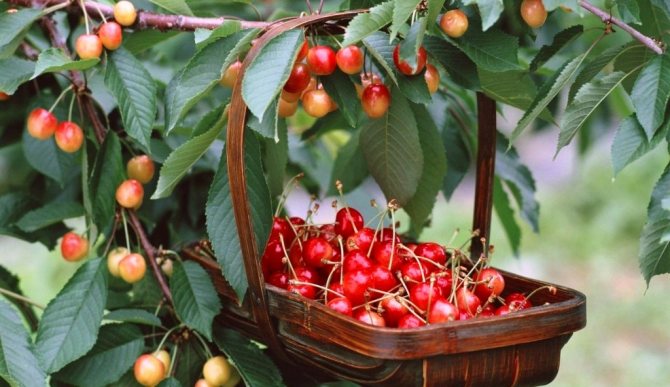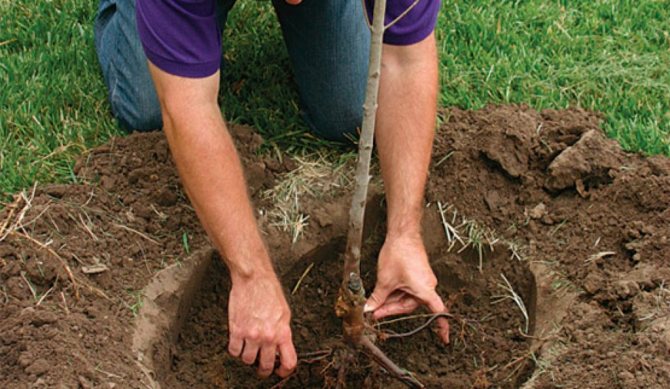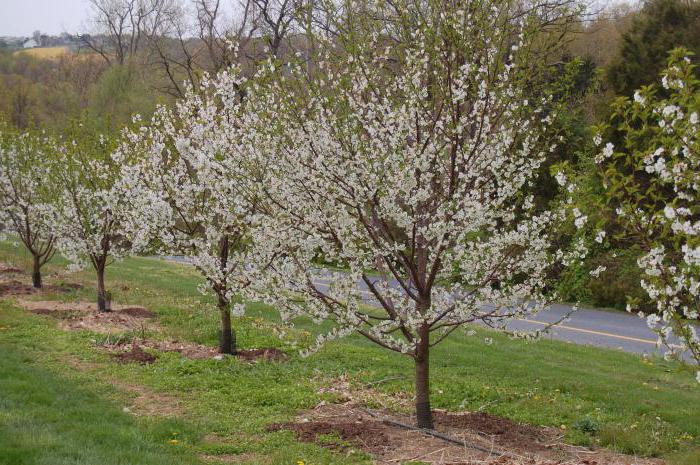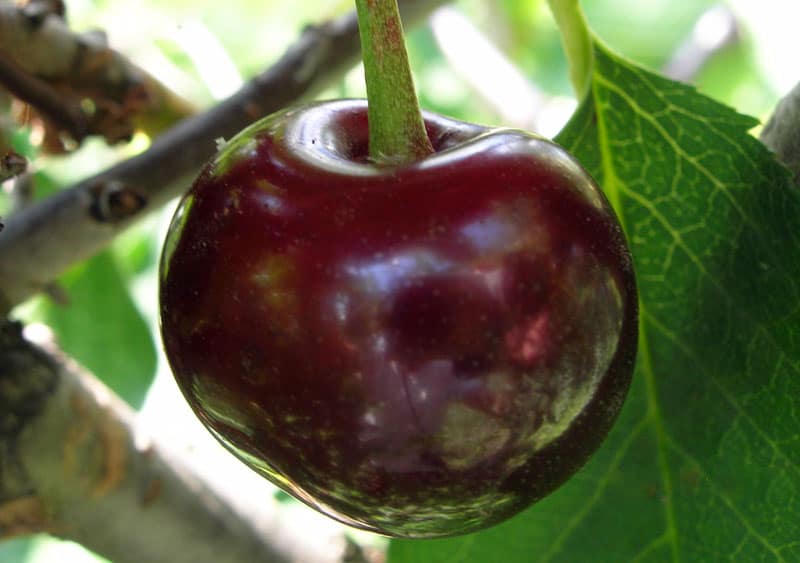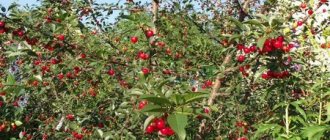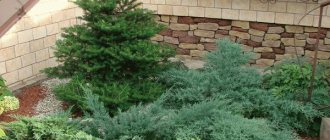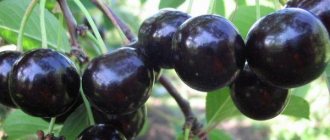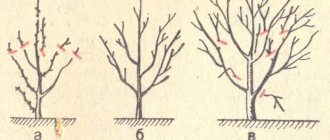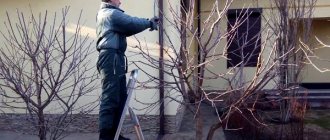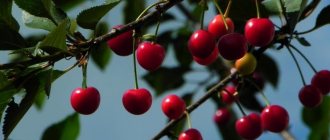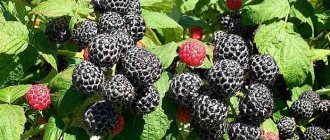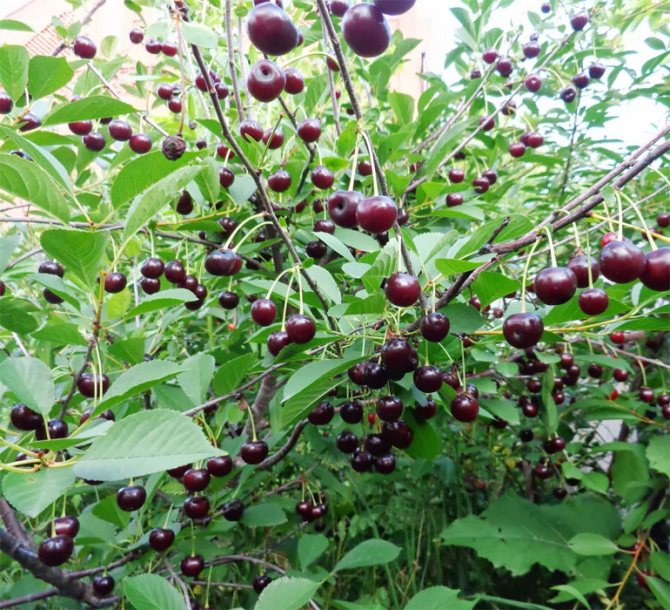
Shokoladnitsa is the result of a successful selection of domestic researchers. The variety is moderately resistant to frost, drought, grows in the form of a low, spreading tree, bears fruit abundantly with large maroon sweet berries. Cherry Shokoladnitsa, a description of the variety, photos and reviews of which are collected in the material, has not lost its popularity among gardeners for many years. For successful cultivation, it is recommended to pay attention to the condition of the seedling, the method of planting and the prevention of fungal diseases.
Description
The height of an adult tree reaches a maximum of 2-2.5 meters. Carved oval leaves form a semi-dense crown in the form of a reverse pyramid. The lower branches dry up as they grow, raising the crown above the ground. The main trunk is covered with glossy brown bark, shoots are grayish brown.
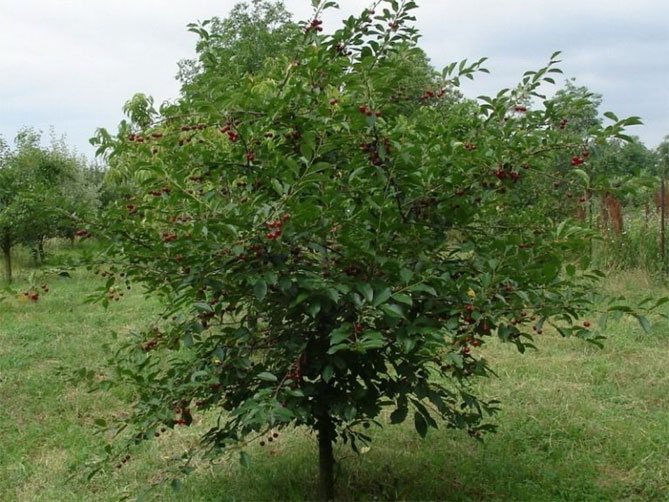

When flowering, among the matte dark green leaves, snow-white inflorescences appear in the form of an umbrella. The flowering period falls in May (more exact dates depend on weather conditions, region of cultivation).
On a note. The chocolate girl belongs to self-fertile varieties - she does not need a pollinator. However, if possible, it is advisable to plant it next to other varieties of cherries, which will help to get the maximum fruit set after flowering.
Berries are formed on perennial shoots. To prevent the crown from thickening, thinning pruning is carried out. Fruiting starts from 4 years after planting the seedling. The maximum growing season does not exceed 20 years.
Description of the correct planting of the tree
Seat selection
Cherries are planted in well-lit areas, sheltered from the winter winds. Damp lowlands with acidic peaty soil and close groundwater, northern slopes are not suitable. The preferred option is sandy loam and loamy, with a neutral reaction.
Fertility and pollinators
Cherry Shokoladnitsa compares favorably with other varieties with a very high self-fertility and can give a good harvest without a pollinator.


Blooming cherry - garden decoration
It is considered one of the best pollinators for Vladimir cherry. Can be pollinated by Lyubskaya, Turgenevka.
Choosing a seedling when buying
A good seedling should have a uniformly developed root system with small lateral roots, a straight stem with smooth bark without damage and 3-4 evenly spaced lateral shoots.
Important! Buy cherry seedlings only from reliable nurseries!
Landing dates
In the northern and central regions, cherries are planted exclusively in the spring, namely in April. In the south it is possible in autumn (September-October). Acidic soils are preliminarily limed.
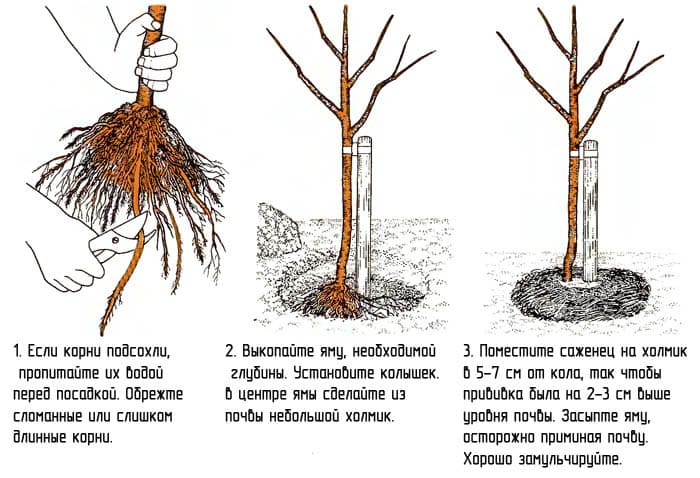

Do not forget to tie the planted seedling to the stake
Pits for planting are prepared in advance (for spring planting - in the fall, for autumn planting - a month before planting). The width of the holes is 0.7–0.9 m, the depth is 0.4–0.7 m. The distance between the trees is from 2–2.5 to 3-4 m.
Step by step process
- A stake is installed in the pit for a sapling garter.
- A mixture of soil extracted from it with rotted organic matter (compost, humus) is poured into the pit to make a mound.
- The seedling is placed on a mound so that after planting its root collar is at the same level from the ground surface.
- Roots are gently spread.
- The pit is covered with earth mixed with organic matter.
- Carefully compact the soil in the pit so that there are no voids near the roots.
- Water abundantly (2-3 buckets of water per 1 seedling).
- Mulch with peat or humus.
- Tie the seedling to the stake.
Planting cherries - video
Features and main characteristics
The variety was bred as a result of crossing of two types: Black consumer goods and Lyubskaya. The development of breeders of the All-Russian Research Institute of Breeding of Fruit Crops Taisiya Trofimova, Adelina Kolesnikova and Maria Mikheeva entered the state register in 1996.
The main characteristics of the Shokoladnitsa cherries are presented in the table
| Indicator | Characteristic |
| Variety name | Chocolate girl |
| Originator | VNIISPK (1996) |
| A type | average fruit ripening |
| Pollinators (optional as the variety is self-fertile) | varietal cherries that coincide in terms of flowering (Vladimirskaya, Lyubskaya) |
| Flowering period | second decade of May |
| Ripening period | first - second decade of July |
| Description of the crown | semi-dense, in the form of an inverted pyramid, composed of matte, large, oval leaves with carved edges and a pointed tip |
| Berry flavor | rich sweet and sour (sugar content about 12%), firm flesh, bright ruby color |
| Description of fruits | dark red, with a burgundy tint, wide rounded shape, weight about 3.5 g, bone takes 8% of the berry weight, is well extracted; |
| Fruiting | comes 4 years after planting (the first year can be weak if no other crop varieties grow nearby) |
| Vegetation period | 15-20 years old |
| Frost resistance | withstands moderate frosts, for the winter requires hilling and wrapping the trunk in order to protect it from rodents |
| Diseases and pests | susceptible to attack by aphids, cherry tubewert, affected by moniliosis, coccomycosis, requires preventive measures |
| Yield | up to 100 c / ha |
On a note. The chocolate girl can be classified as a sweet variety. The tasting score of taste is 4 out of five points according to gardeners' reviews.


Recommended growing regions, endurance
Cherry variety Shokoladnitsa is zoned in the Central region, suitable for cultivation in the following regions:
- Tula;
- Moscow;
- Ryazan;
- Vladimirskaya;
- Bryansk;
- Smolenskaya.
On the territory of Belarus, Ukraine, cherries do not freeze out, bears fruit abundantly, as evidenced by the reviews of summer residents.


According to the registry data, the variety is frost-resistant. Tolerates temperatures typical of the Central Region. Average frosts within -10 ° С, -20 ° С are not terrible for the tree. However, if the temperature drop is predicted to -30 ° C, -35 ° C, it is advisable to cover the lower part of the trunk with spruce branches.
Recommendation. For the arrival of frosty weather, experienced summer residents prepare stone fruit crops in the fall. After abundant leaf fall, the near-stem area is cleared of foliage, dug up, covered with spruce branches (hay, straw, sawdust). The trunk and the lower tier of branches are wrapped in natural breathable fabric. It protects against bad weather, protects the tree from rats, rabbits, and other rodents eating the bark.
The variety is well adapted to dry periods. Due to the developed root system, a mature tree does not require additional watering, there is enough natural precipitation. Watering is only necessary for young growth in the first 2-3 years after planting.
Taste qualities
The characteristics of the fruits are as follows:
| Name | Value |
| The form | rounded, wide, flattened above and below; |
| Berry size | large; |
| Weight | 3.6 g; |
| Height | 1.6 cm; |
| Width | 1.9 cm; |
| Peduncle | 3.6 cm |
| Bone | yellow, well separated, approximate weight 0.3 g; |
| Peel color | dark red, almost black; |
| Pulp color | saturated red; |
| Pulp consistency | dense, elastic. |
On a note. This variety is suitable for fresh consumption and conservation. The sweetness is moderate, the sugar content is 12%. Due to the fact that the stone is easily removed, cherries are used for making desserts, baking, and jam.For the preparation of compotes, the bone is not removed.
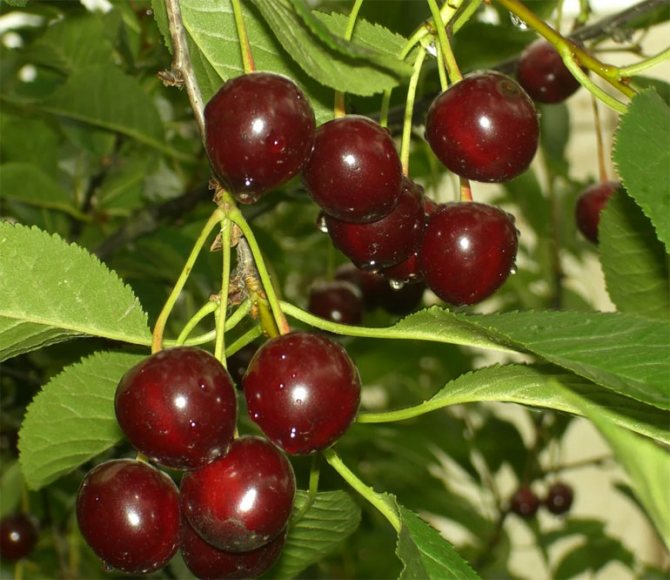

Pollination
The chocolate girl is self-fertile. This means that fruiting does not depend on the trees growing nearby. However, the close proximity of other cherry trees can affect yields to some extent, allowing the flowers to be pollinated efficiently even in years with poor flowering weather. The culture blooms with simple flowers, collected in inflorescences of 3-5 buds. The ovary is actively formed at the end of May, the fruits ripen by July.
One of the disadvantages of many varietal stone fruit crops is poor pollination. When growing Shokoladnitsa, the question may arise why the cherry does not bear fruit. There are several reasons:
- the tree has not reached maturity, Shokoladnitsa begins to bear fruit from the age of 4;
- despite the fact that the variety is classified as self-pollinating, the crop may have difficulties with pollination (in this case, planting other varieties of cherries in the immediate vicinity can help).
Yield
Planting different varieties in the neighborhood increases the yield:
- the yield of a lonely tree is from 60 centners per hectare;
- the yield of a tree grown in a garden next to other varieties of cherries can reach 95-100 centners per hectare.
For information. Similar indicators in comparison with other varieties are considered average (for example, Turgenevka gives up to 200 c / ha).
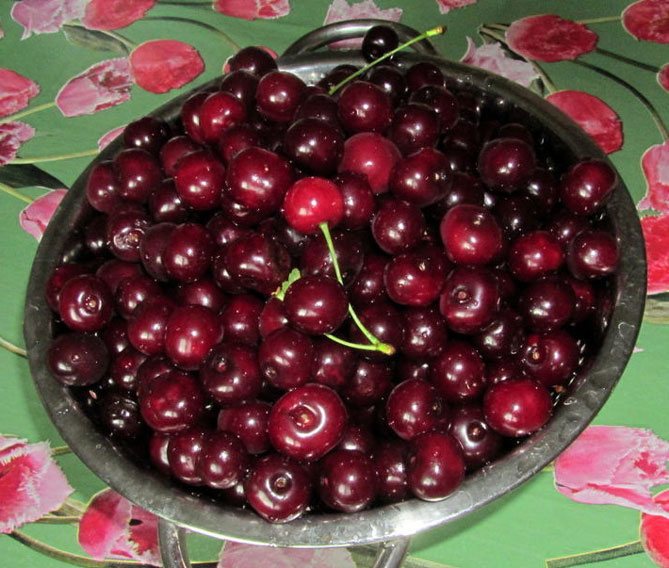

Disease and pest resistance
Reviews of the Shokoladnitsa cherry say that the variety is weakly resistant to the manifestation of viral diseases. Due to improper care, poor preparation of the tree for winter, leaves, bark and fruits can be affected:
- cocomycosis,
- moniliosis,
- clotterosporiosis.
Recommendation. To avoid such troubles, it is necessary in the spring to carry out preventive spraying with Bordeaux liquid after the appearance of the leaves and before flowering.
Periodically, in spring and summer, young shoots and new leaves attack:
Advantages and disadvantages
Photos of Cherry Shokoladnitsa demonstrate the main advantages of culture:
- short stature,
- fruit color and size,
- an abundance of fruits.
Thanks to these characteristics, the variety has gained popularity among gardeners. However, this species has features that complicate cultivation.
The main advantages and disadvantages of Shokoladnitsa are shown in the table
| Advantages | disadvantages |
| self-fertility (no need to plant a pollinator nearby) | the need for timely treatment from pests |
| resistance to frost, drought | bird-eating |
| the possibility of forming a crown into a low standard tree or bush | the need for systematic measures to prevent fungal diseases |
| rich color and taste of fruits |
Harvesting, storage and use
Cherries begin to ripen in mid-July. It is possible to harvest for long-distance transportation 6-7 days before full ripening, for conservation - in 3-4 days, and for fresh consumption - when fully ripe.
For storage, the fruits must be plucked with stalks, but so as not to damage either the berry itself or the fruit wood. It is best to cut the stem 2/3 of its length with sharp scissors.


Cherries, which are supposed to be transported, are best picked a week before ripeness.
Put the collected berries in buckets or baskets, carefully so that the stalks do not pierce the neighboring fruits. The crop is stored for a short time - 5–7 days in the refrigerator (when frozen - 1–1.5 years).
Chocolate Girl berries contain quite a lot of acids and sugars, they can be eaten both fresh and processed. Jams, jams, marshmallows, compotes, liqueurs, dried fruits are prepared from cherries of this variety.
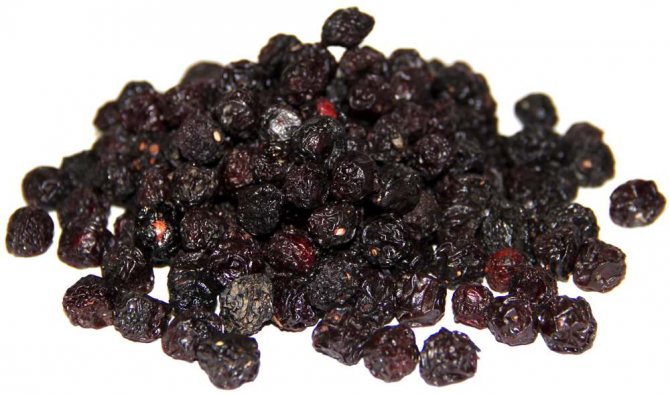

You can make dried fruits from Shokoladnitsa for the winter
Testimonials
This season, Shokoladnitsa received the first good harvest, planted 3 seedlings 4 years ago, then there was a special excitement about the variety, many talked about it. There was no trouble with the tree.The crown is compact, as they say in the varietal description - a small piece of land is suitable for planting, if only a sunny position. Trees hibernate without problems. The cultivars were not planted by pollinators, the cherry is self-fertile. Three young cherries were harvested under 40 kg, which is a lot for this age.
Shokoladnitsa is growing at the dacha, already 8 years old. I like very much the taste and rather strong aroma. Cherries are very sweet compared to other varieties, I like them. Self-fertile, pollinators are not required, but a Turgenev tree still grows on the site, there are many ovaries after flowering. From leaving I carry out sanitary pruning, sometimes I thin out the crown a little. After flowering, I water it.
Cherry winters well, gives a relatively high yield. I can say about Shokoladnitsa that the description really corresponds to reality. Excellent taste, compact size. Of the shortcomings, it is sensitive to moniliosis in rainy years, I spray it with Horus for prophylaxis, so there are no problems.
Cherry Shokoladnitsa is a rather young variety that has gained great popularity. The culture belongs to unpretentious plants, it perfectly tolerates drought, frost and does not require careful maintenance.
Breeding history
The variety was bred in order to obtain a frost-resistant crop with a small crown size, as well as tasty and attractive fruits. Shokoladnitsa was obtained at the research institute for selection of fruit crops by crossing the previously known varieties of cherries Lyubskaya and Shirpotreb black, after which in 1996 it was entered into the state register of fruit crops.
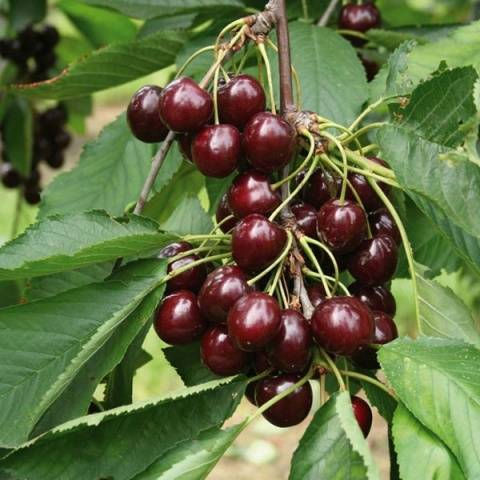

Description of culture
There are distinctive features of the Shokoladnitsa cherry variety. The height of a tree in an adult state can reach 2.5 meters, while the maximum growth is gained by the third or fourth year of the plant's life. The crown is usually an inverted pyramidal shape. The leaves, like most cherry varieties, are spiky, without a characteristic sheen, dark green. Inflorescences are white.
The dark color of the berries and the slight bitterness in the taste can be confusing. By the taste of the berries, it is not always clear what the Shokoladnitsa is: a cherry or a cherry. This is a cherry variety, the berries of which have a dark shade, sweet taste, with a note of sourness and bitterness.
How to choose seedlings
You can plant grafted or own-rooted trees. When choosing planting material, they are guided by the following rules:
- smooth center conductor;
- the height of the seedling is about a meter, and the trunk diameter is from 1.5 to 2.5 cm;
- the root system is well developed, the roots are lively, moist, flexible, whitish-green;
- a two-year-old seedling must have three or four lateral skeletal branches;
- there should be no leaves on the branches;
- absence of damage, signs of disease, the presence of pests;
- if the seedling is grafted, there are no slugs at the junction of the rootstock and the scion.
Before planting, the roots of the seedling are dipped in a liquid mixture of manure and clay, the so-called talker. This procedure promotes better plant survival.
Seedlings should always be purchased in specialized nurseries, from trusted suppliers, so as not to run into infected seed, a completely different variety, a sterile specimen, wild.
Experienced gardeners prefer to buy Shokoladnitsa seedlings in the fall, when there is a richer choice. To keep the cherries until spring, they are buried in the grooves, and spruce branches are placed on top to protect them from rodents.
Advertisement 1
Characteristics
Cherry Shokoladnitsa, a photo of the tree of which is presented below, belongs to rather early and unpretentious varieties. It is drought tolerant, tolerates frost favorably, and also yields a rich harvest by the age of 4.
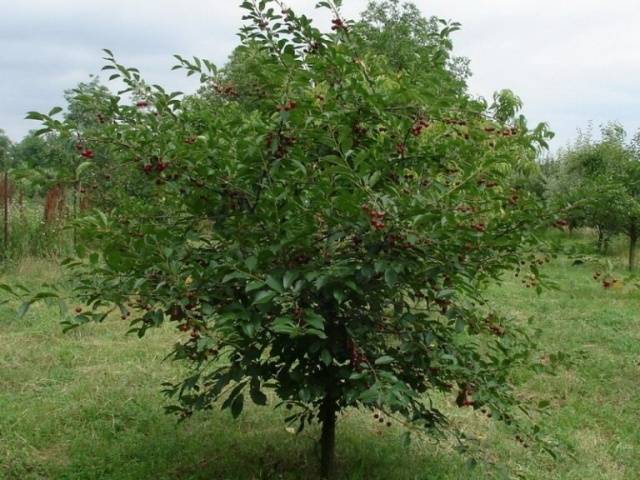

Drought resistance, winter hardiness
One of the main advantages of the variety is its high resistance to low temperatures and lack of moisture.That is why the variety is successfully grown in many regions of our country, although it was originally recommended for planting in the central part of Russia.
Pollination, flowering and ripening period
The flowering period of the crop falls on the first third of May, and the first crop can already be harvested by the 20th of June. But it is worth remembering that the first fruits do not appear earlier than 3-4 years after the seedling is planted in its permanent place of growth.
The main pollinators for the Shokoladnitsa cherry variety are the Griot cherry, the Sklyanka and Vladimirskaya cherry varieties. Therefore, it is recommended to plant this variety with the above crops.
Productivity, fruiting
High yield is another of the main advantages of the Shokoladnitsa variety. From one adult tree, you can collect about 10 kg of ripe and tasty berries. This is considered a pretty good indicator for such a short tree.
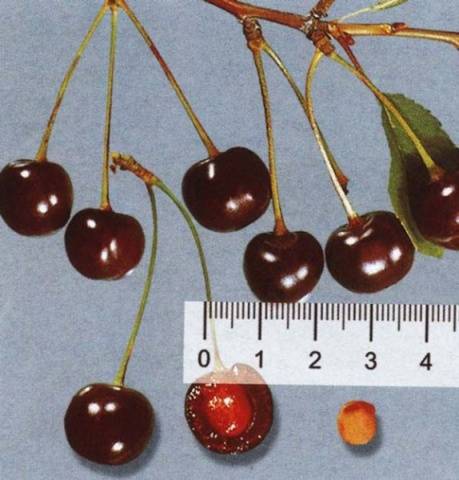

Scope of berries
Like many varieties, the Shokoladnitsa dwarf cherry, namely, its fruits are widely used in cooking:
- boil compotes;
- make preserves and jams;
- make natural marshmallow;
- dried in an oven or special equipment, as a result of which dried fruits from cherries are obtained;
- both whole berries and cherry puree are frozen for the winter.
The blanks are used in baking, making a variety of sauces and drinks.
Disease and pest resistance
Cherry varieties Shokoladnitsa can be exposed to coccomycosis, moniliosis and aphids. However, with proper care and handling of the crop, contamination of leaves, branches and bark can be avoided. Plus, the lack of long branches leaning towards the ground prevents other pests from colonizing the plant.
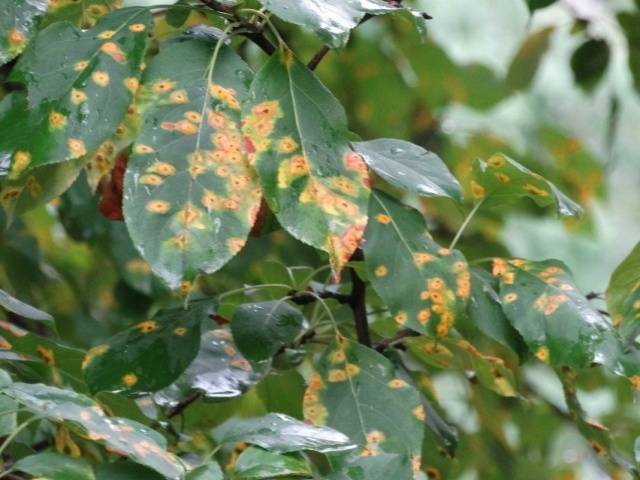

Advantages and disadvantages
Summarizing the above, the following advantages of the Shokoladnitsa cherry variety can be distinguished:
- compact crown, facilitating the care process and reducing the risk of infestation of insect pests;
- high resistance to drought and frost;
- fast ripening of fruits;
- the possibility of self-pollination.
The disadvantages, in turn, include:
- the need for regular treatment against fungal diseases and pests;
- lower yield compared to other larger varieties.
Despite the lack of resistance to fungal infections, this cherry variety is considered one of the best for cultivation.
Landing features
Compliance with all planting rules, site selection and seedling preparation - all this plays an important role in the further growth of the culture, its fruiting and resistance to adverse environmental conditions.
Choosing a landing site
The cherry variety loves sunny and open places. If on the site intended for planting there are any structures or other large plants, then Shokoladnitsa is best planted on the south side of them. In this case, a favorable microclimate is created for the seedling, and nothing will prevent the ingress of sunlight.
It is necessary to plant the culture in the spring, but if the seedling was bought a little in advance, then it is best to dig it into a hole 40 cm deep, fill the root system and trunk before branching with soil. After that, cover with spruce branches, this will keep the seedling in its original state.
Planting Cherry Shokoladnitsa in spring is carried out in a light and neutral sandy loam soil.
Selection and preparation of planting material
It is only necessary to choose any planting material, including this cherry variety, in proven, specialized nurseries, in which professionals in their field will be able to give all the recommendations for care. And it is best to do this at the beginning of autumn.
Preference should be given to not too high specimens. It is important to examine the shoots for their number (8-12 pieces depending on the age of the plant and 15-25 cm long), as well as their external state.
The optimal volume of the root system should be within 2535 cm.The cherry bark should not have any damage, fungal infections, the roots should be moderately moist, without kinks, swellings, with a large number of branches.
Landing algorithm
Stages of planting Cherry Shokoladnitsa:
- Pit preparation. Its size should be approximately 70 cm (width) and 65 cm (depth). The excavated soil is mixed with organic, potash and phosphorus fertilizers and poured back into the pit, while forming a small mound.
- At the top of the mound, a cherry seedling is installed, straightening all the lateral roots. The root system is sprinkled with the remaining soil, compacted and poured in with about 3 incomplete buckets.
- After the soil has settled, you can also add on top of the soil, and then tie the tree to a support next to a dug-in stick.
How and when to plant seedlings correctly
The first step is to carefully choose a place to plant the tree. You can plant seedlings both in spring and autumn. When choosing a seedling, it is necessary that its height does not exceed 70 cm. He must be young, and his root system must be powerful and developed. The branches must be firm and resilient.
To get a bountiful harvest, you need to plant your cherries in a well-lit area, sheltered from the wind. If the soil on the site is heavy, then it is worth adding sand, peat to it. You also need to pay attention to the level of the location of groundwater.
Cherry Shokoladnitsa does not tolerate too wet soil. So you have to take care of the drainage. Otherwise, the tree will simply die.
It is necessary to extract earth from the hole and prepare the bottom layer, which will consist of soil, ash and humus. Add superphosphate and potassium chloride to the mixture. Such a hole should be performed in the fall, then planting activities can be carried out in the spring with the beginning of sap flow.
But what is the height of the Morozova dessert cherry tree, and how large its fruits are, indicated here.
The video shows the rule of planting seedlings:
When planting a seedling, the following sequence of actions must be observed:
- Take a stake, set it in the center of the hole... But the depth of the pit itself should be about 70 cm.
- Place the resulting nutrient mixture into it.
- Place a seedling there, spread the roots. Do this carefully so as not to damage them.
- Attach the plant to the stake using paper string... But plastic ropes cannot be used, as they can injure a young tree.
- Install the seedling so that its neck is concentrated above the ground in the region of 3-4 cm.
- Cover the hole with earth, tamp it and water it using 10 liters of water.
- After watering, be sure to lay a layer of mulch. Its thickness will be 5 cm, but sawdust and humus will have to be used for this.
maybe
Follow-up care of the culture
Newly planted cherry trees require moderate but frequent watering. After the appearance of the first leaves, you need to mulch the soil and reduce watering.
The basic rules for caring for a plant in the first three years are:
- regular removal of weeds around the seedling;
- loosening and mulching the soil;
- regular watering during dry periods of the year;
- crown formation before bud break.
One of the main conditions for caring for a Shokoladnitsa is a well-established watering regime. Water stagnation in the soil should not be allowed, as this can affect the appearance and taste of the fruits. But it is also categorically impossible to leave the soil dry. One plant takes about 4-5 liters of water.
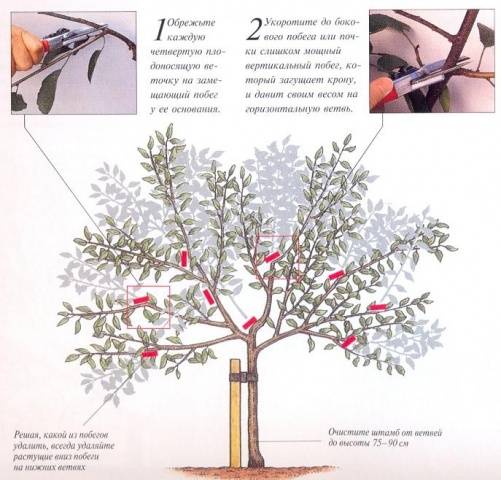

Many people ask the question: what to do if the Shokoladnitsa cherry does not bloom? This can be influenced not only by pests and diseases, but also by a lack of light, a lack of pollinators, and a deficiency of minerals in the soil.
Diseases and pests
The main disadvantage of the Shokoladnitsa variety is its susceptibility to coccomycosis and moniliosis.In the first case, an effective way to eradicate the disease is to sprinkle the tree at the bud stage with a 3% solution of Bordeaux liquid, during the flowering period - with the "Skor" preparation and after harvesting the fruits with a solution of copper oxychloride.
To destroy moniliosis, which manifests itself in the form of fungal plaque on the branches and bark, it is recommended to remove and burn the damaged areas and subsequently treat the culture with a solution of copper sulfate.
Aphids that live on cherries and damage the plant are best removed with a 3% nitrafen solution.
Care
How to care for a seedling?
Freshly planted cherries are often watered - every time the top layer dries up, that is, the soil should always be moist. When young leaves appear on the bush, watering is stopped, the soil is mulched. The chocolate girl began to develop, its roots were fixed in the ground and can extract moisture on their own from the lower layers of the soil. The fertilizers added to the planting pit are enough for the entire growth period, until fruiting.
Care for the first 2-3 years:
- Remove weeds that may compete with the small tree for food, moisture and light.
- Always keep the soil loose and under mulch.
- Water only during dry periods, when the temperature is high for a week, there is no rain. Consumption for one tree is 10-30 liters, depending on age.
- Form the crown. In the spring, before the buds bloom, a one-year-old seedling that does not yet have side branches is cut at a height of 60–70 cm. If you want to form a bush, leave a stem 40 cm high, but at the same time there must be 4–6 buds below the cut, from which shoots will grow ... During the summer, branches of the first order (skeletal) will appear, they are shortened again in the spring, leaving 4–5 buds. Further pruning, as for an adult cherry: sanitary and for thinning the crown.
When forming the crown, skeletal branches should not be left extending from the trunk at an acute angle. The optimal angle is close to 90⁰.
Video: Pruning Small Cherries
Watering a fruiting Chocolate girl
Cherry is a drought-resistant crop, it does not need to be watered uncontrollably by sprinkling and from a hose. In our Russian conditions, it has enough moisture from the rains. In dampness, the roots will rot, pathogenic fungi will settle on the leaves and flowers, the berries become watery, sour, and if you do not stop watering 2 weeks before ripening, the fruits will crack.
Three important periods when cherries need watering:
- The beginning of the growth of leaves and shoots.
- Budding period.
- Formation and growth of ovaries.
4-6 buckets of water are poured under one tree. Watering is needed only in the absence of rain. But sometimes, even if they are available, you have to water if the soil is not soaked to a sufficient depth. Take the time to clean up the mulch and topsoil to make sure the ground is moist. During these periods, at a depth of 30–40 cm, it should shrink into a non-crumbling lump.
Excess moisture after harvesting will provoke the growth of shoots, and it's time for the cherries to prepare for winter. By the middle of summer, flower buds of the next year are laid, the bark on young shoots should ripen before autumn so that the fruit twigs do not freeze. Therefore, again, there is no need to water the cherries. In autumn, at the end of October, only with insufficient rainfall, Shokoladnitsa is given charging watering - up to 9 buckets per adult tree.
Fertilizing cherries - table
| When to fertilize | Fertilizers and dosage | Method of application |
| Early in spring over thin snow or melt water | 50 g of ammonium nitrate per 1 m² of trunk circle | Spread dry evenly |
| During budding | 18 g of potash and phosphorus fertilizers per 1 m² plus humus or compost with a layer of 10 cm | Mineral fertilizers are scattered around the trunk circle, and organic mulch is placed on top |
| After harvest | 1 tbsp. l. potash fertilizer per 10 l of water, consumption per 1 m² of the trunk circle | Make a groove along the periphery of the crown, 10-15 cm deep, apply top dressing and dig in |
Video: Briefly about planting, feeding and watering
Pruning
Pruning is done in early spring, before bud break. Sanitary pruning may be required during the summer if the tree is affected by disease. Stock up in advance with garden pitch, special putties Rannet, BlagoSad, or at least ordinary plasticine. Wounds over 1 cm in diameter must be covered. By the time of fruiting, the crown is already formed. The purpose of the annual spring pruning is thinning.
What branches to remove?
- All sick, dry, frozen (to healthy wood).
- Curves, broken off, ugly, sticking out strongly to the sides, interfering with the gardener.
- Growing vertically upward from skeletal.
- Growing inward towards the trunk.
- Rubbing and interfering with each other.
The shoots are cut out as they appear. The sooner, the less juice it will take from a fruiting tree.
Preparing for winter
The chocolate girl tolerates the winter well. Even if some branches freeze, it will quickly recover in the spring. Roots need special protection. The trunk circle is dug to a depth of 15 cm, covering up the old mulch. Then they cover it with breathable material: dry grass, straw, spruce branches. Trunks and skeletal branches must be whitewashed with garden lime to protect them from sunburn in February and March. From rodents, the stem from the soil itself to the level of snow is tied with spruce branches (down with needles), nylon stockings, non-woven covering material and other breathable materials.
Video: Shelter a small tree for the winter entirely
In early spring, rodent protection is removed as early as possible. But snow melting is often prevented. If Shokoladnitsa blooms when there are still spring frosts in your region, then flowering can be postponed to a later date. To do this, in early spring, when not all the snow has melted, it is raked to the cherry and covered with straw, sawdust, etc. The earth will warm up longer, the Shokoladnitsa will wake up later and bloom.
History of creation
When breeding a new cherry variety, the breeders set themselves the following tasks: to create a tree that would have a small crown, resistance to severe frosts, and the berries were tasty and beautiful.


And scientists from the Research Institute of Breeding of Fruit Crops managed to develop such a variety. This was the Shokoladnitsa cherry, for which we crossed the varieties of cherries Lyubskaya and Consumer goods black.
The originators of the variety are breeders from the Oryol Research Institute A. F. Kolesnikov, M. V. Mikheev, T. A. Trofimov. After testing, the new cherry was added to the State Register of Russia in 1996; the variety is recommended for growing in the middle lane and in the Central region.
Cherry Shokoladnitsa: description and characteristics
Description of the cherry variety Shokoladnitsa should start with a story about the tree itself. Its height can reach 2.4-2.6 m, and the maximum height of the bush is formed by the 4th season of life. Crohn - inverted pyramidal. The foliage is elongated, pointed, devoid of characteristic shine, its color is dark emerald. The flower petals are boiling white.
The low crown allows for harvesting without the need for ladders or other devices.
The color of ripe berries is dark, not typical for cherries, and there is a bitterness in the taste of the fruits, which can confuse novice gardeners who think that this variety should be attributed to a sweet cherry. But experts say that Shokoladnitsa is a cherry variety with a peculiar color and taste of fruits that are not typical for these berry trees.
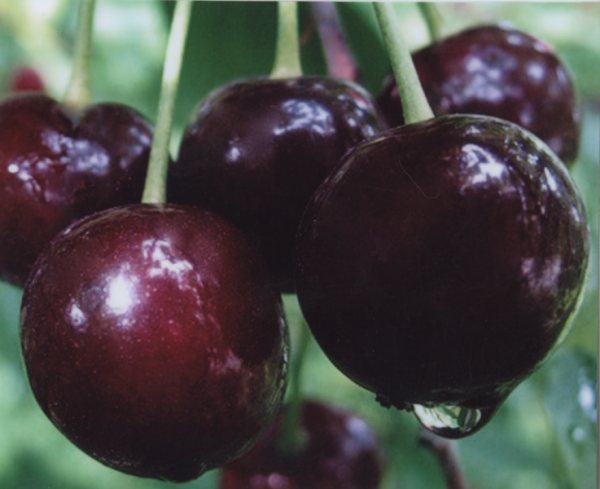

Ripe cherries contain about 12% sugars and no more than 1.6% acids, so the taste of the berries is original - sweet with a slight sourness.
This berry tree belongs to the early varieties, is unpretentious to growing conditions and care, calmly tolerates a long period of drought, begins to bear fruit already in the third season from the moment of planting, and gives the first rich harvest in 4 years of life.
Harvested berries are widely used in cooking - they prepare compotes, preserves, jams, marshmallows, make dried fruits, and freeze.
The harvest of the Chocolate Girl even in the refrigerator is not stored longer than 2-3 days, only the berries collected from the stalk can lie for up to 10 days.
Frost resistance
The main advantages of the Shokoladnitsa cherry are its frost resistance and ability to withstand drought. It is also important that this variety proved to be resistant to spring frosts, due to which flower buds perish on other cherry varieties.
Therefore, the Chocolate Cherry can be found in Eastern and Western Siberia, as well as in the Urals - in these regions it does not undergo freezing and gives stable high yields.
Cherry Shokoladnitsa - video
Cherry pests - table
| Pest | Description | Ways to fight |
| Aphids | Small insects up to 3 mm live in colonies on the back of the leaf and young succulent shoots. On cherries, aphids are usually black, although green ones are more common in nature. Up to 20 generations are born per season, so it is difficult to deal with such pests on fruit-bearing trees. Aphids do not cause much harm to an adult and healthy tree, but they can bring viral diseases from neighboring gardens and vegetable gardens. |
|
| Cherry fly | The pest most of all affects mid-season cherries with sweet berries. Shokoladnitsa belongs to such varieties. Small flies up to 5 mm with striped wings fly out of the soil in early June, feed on the juices of damaged leaves. After 2 weeks, the females pierce the berries and lay eggs in the juicy pulp. Cherries, eaten from the inside by the larvae, darken, lose their gloss and dry out. |
|
| Cherry pipe wrench | Beetles can be recognized by their "proboscis" - the rostrum. The length of the insect is 6–8 mm, the color is golden-green with a cherry-colored metallic sheen. Adults leave winter shelters before flowering, climb into buds, feed on pistils, stamens, leaves, ovaries. After 10-12 days, the females gnaw through the passages in the berries to the very bone and lay one egg on each. The larvae climb into the still soft bones and feed on their contents. The berries do not crumble, but they grow small and tasteless. |
|
Photo gallery: The most common cherry pests


Aphids feed on juices of young juicy leaves and shoots
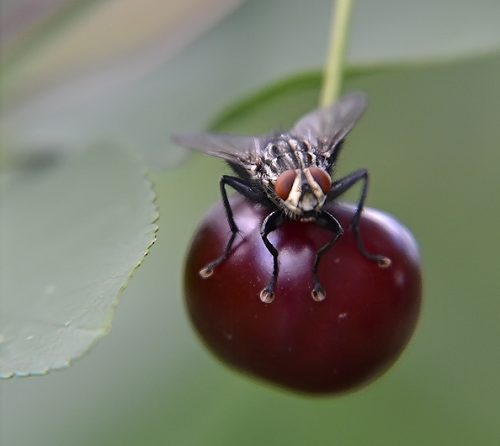

Cherry fly lays eggs in berry pulp
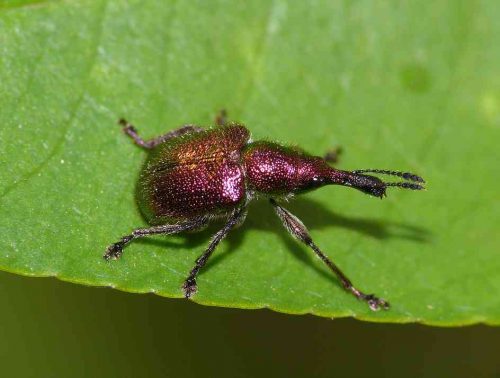

The cherry tubework feeds on the contents of the buds, and its larvae eat the seeds
Flowering period and pollinating trees Shokoladnitsa cherry
The Shokoladnitsa variety begins to bloom in the first decade of May, and ripe berries are harvested at the end of June. But flowering and fruiting begin in the Shokoladnitsa cherry only in the third - fourth season after planting the seedling in a certain place in the garden.
Although this variety is self-fertile, that is, it does not need to be planted with a number of pollinating trees, many gardeners, to increase the yield of Shokoladnitsa cherries, plant other varieties of this berry tree nearby - Vladimirskaya, Turgenevskaya, Lyubskaya, Studencheskaya and a number of others, the flowering times of which coincide with Chocolate girl. Also, Griot cherry will be an excellent pollinator for Shokoladnitsa cherries.
But when planting different varieties of cherries next to each other, you need to take into account the size of the crown of these trees so that they do not shade each other in the process of growth and development. If necessary, increase the distance between the planted cherry trees.
Advantages and disadvantages
Experts refer to the undoubted advantages of Shokoladnitsa cherries:
- high productivity;
- early periods of flowering and ripening of berries;
- excellent taste of ripe cherries Shokoladnitsa;
- good presentation of ripe berries;
- the harvested crop calmly transfers transportation over long distances, without losing its excellent presentation and taste;
- high resistance to drought and frost;
- the variety is partially self-fertile, so the presence of other cherry varieties nearby is not necessary;
- the first bountiful harvest can be harvested within 3-4 seasons after planting the seedlings.
However, this cherry also has a serious drawback, which many gardeners talk about:
- low resistance of the variety to the main diseases affecting cherry trees - coccomycosis and moniliosis;
- Information on other shortcomings of Shokoladnitsa cherries is currently not noted
Cherry Shokoladnitsa - photo on the bush
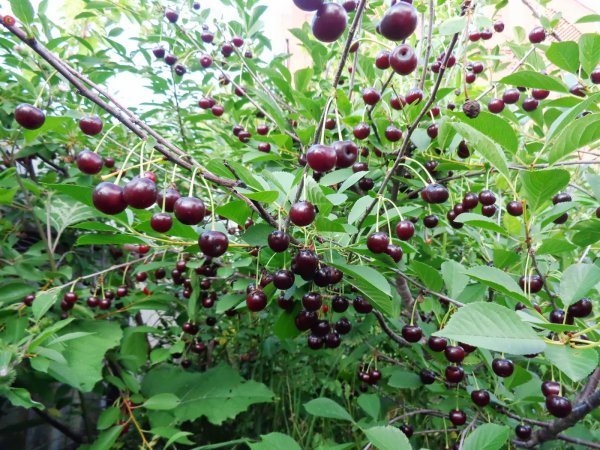

Cherry Shokoladnitsa: growing and care
This cherry tree does not require complex care, it is enough to follow the basic rules of agricultural technology for the variety.
Landing
Before buying a seedling of this cherry, you should choose a place where it will grow. A well-lit area, protected from gusts of wind and strong drafts, without stagnation of moisture in the soil, is ideal. And the groundwater level should not approach the earth's surface closer than 3-3.5 m.
It is better to plant the Shokoladnitsa cherries directly in the spring, especially in regions with not the warmest winters. If you plant trees in the fall, then the risk increases that an insufficiently surviving plant will winter badly and freeze out.
Optimal conditions and care for abundant fruiting
Cherries prefer to grow on neutral or slightly acidic soil. The soil should not be too wet. That is why it is not recommended to flood trees. The Shokoladnitsa hybrid is classified as light-loving, so the seedlings are planted in open sunny areas. The gardener needs to know that in the shade, the yield will be low, and the berries themselves are small. Several times a month, the soil around the trunk is loosened and all weeds removed. Leaving weeds to grow in the garden increases the risk of harmful insects.
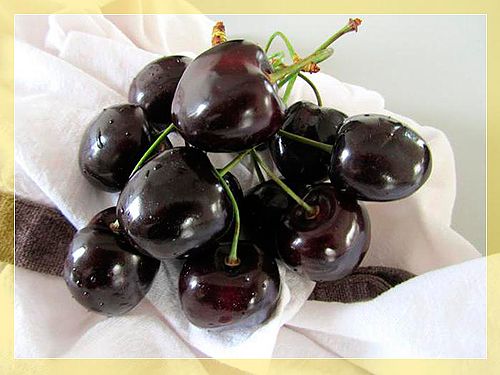

First of all, to increase productivity, mineral and organic fertilizing is introduced into the soil. Dry and diseased branches are cut annually.
Soil requirements
As mentioned above, Shokoladnitsa prefers to grow on neutral or slightly acidic soils. It is not recommended to plant seedlings in wetlands or near groundwater. Excessive soil moisture negatively affects the health of the tree. It is advisable to choose a loose and fertile soil. Cherry grows worse on heavy soils. Planting is carried out only in sunny areas.
Regularity and rates of watering
Due to their drought tolerance, trees can easily tolerate dry soil. Therefore, trees can be watered several times a month. If there is not a lot of precipitation in summer, then the cherry is watered 4 times per season. The first watering is carried out immediately after flowering. The second time the plant is moistened in the second decade of June. The third watering is immediately 14 days before the start of the harvest and the last time the plant is watered a month before the onset of autumn frosts.
See also
Description of varieties of black cherry Morel, Rossoshanskaya and Shokoladnitsa, planting and careRead
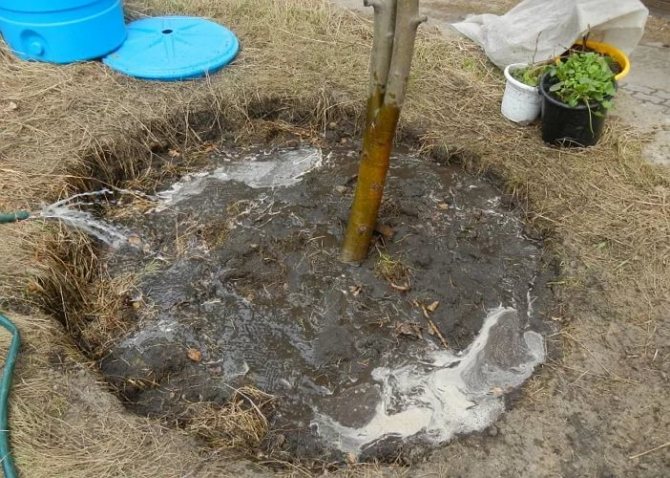

3-4 liters of water is enough for 1 tree. It is advisable to avoid waterlogging of the soil. Before watering, the soil near the trunk is loosened and weeds are removed. It is recommended to pour over the cherries with warm water. If cold water is used for humidification, the risk of fungal diseases increases.
Top dressing
To increase the yield, mineral and organic fertilizing is introduced into the soil several times per season. With the onset of autumn, 85 g of potassium and 250 g of phosphorus are introduced into the dug soil. Every three years, while digging up the soil, compost or humus is applied. In the spring, nitrogen-containing fertilizers are introduced into the soil in an amount of 60 g.Ammonium nitrate or urea is added to the soil.
During the growing season, fertilizing is applied to the ground twice. The first time the cherry begins to bloom and the second time two weeks after the flowering period to stimulate the formation of ovaries.
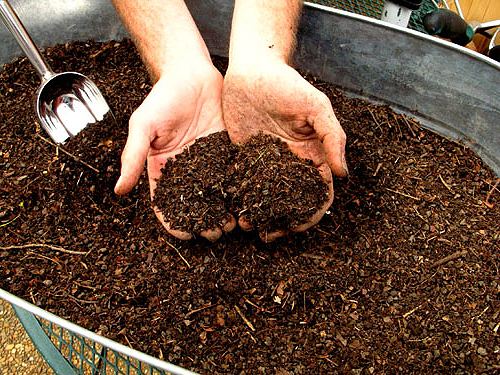

The following fertilizers are used:
- 10 liters of mullein are mixed with 1 kg of wood ash and 50 liters of warm water are poured.
- The infusion is left for 4-5 days.
- After the fertilizer is ready, take 5 liters of infusion and 3 buckets of water per tree.
In addition, it is useful to use minerals. For example, 20 g of potassium chloride and urea are diluted in a bucket of water, 25 g of superphosphate are added. This solution must be applied in the same way as organic matter.
Preparation for wintering
Since Shokoladnitsa belongs to the winter-hardy, before the onset of winter, special efforts are not required to prepare the tree for the cold. After harvesting, the soil is dug to a depth of 20-30 cm. Dry branches are also cut off before the onset of winter.


If the winters in the growing region are very cold, the soil around the trunk is mulched. The branches bend slightly before the onset of cold weather. Those branches that are more than 8 years old should be pruned. The pressed stems are covered with straw or hay. With the onset of winter, the areas around the trunk are buried with snow so that the roots do not freeze.
With the onset of autumn, young seedlings must be mulched with peat or a thick layer of sawdust and covered with a special cloth
Diseases and pests of cherry crops
The main diseases to which the Shokoladnitsa cherry is susceptible are coccomycosis and monoliosis.
The causative agent of monoliosis can enter the branches of a tree during pruning through cuts. Therefore, during this procedure, only a thoroughly disinfected instrument should be used, the cut points should be immediately processed with chopped charcoal or garden varnish. Also, for the prevention of the disease, treatment with a solution of copper sulfate or Bordeaux liquid should be given in the spring. Antifungal drugs can also be used to process the crown of the Shokoladnitsa cherry.
Aphids can settle on the green mass of pests. You can fight it with folk remedies (processing with garlic or tobacco infusion), or use the appropriate fungicides if the colonies of these insects are too numerous.
Since the shoots of this cherry do not bent low to the surface of the soil, other pests usually cannot reach it.
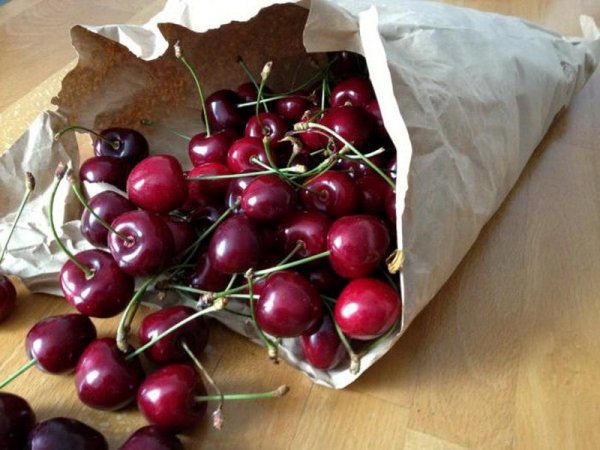

Diseases - table
| Disease | Symptoms | Prevention and treatment |
| Coccomycosis | The leaves are covered with brown specks, turn yellow and crumble. Sometimes at the end of June the trees are bare. | All fungal diseases are treated in the same way:
|
| Moniliosis | The leaves at the tips of the branches hang, as if withering, then turn brown and dry. In this form, they remain on the tree for a long time. | |
| Clasterosporium or perforated spot | The disease affects cherries weakened by moniliosis, coccomycosis and other diseases. Brown spots appear on the leaves, they dry out and crumble, forming holes. | |
| Gum therapy | Drops of resin appear on the bark in places of mechanical damage, frostbites, sunburns. Cherry loses strength, becomes susceptible to disease. |
|
Photo gallery: What can Shokoladnitsa get sick with?
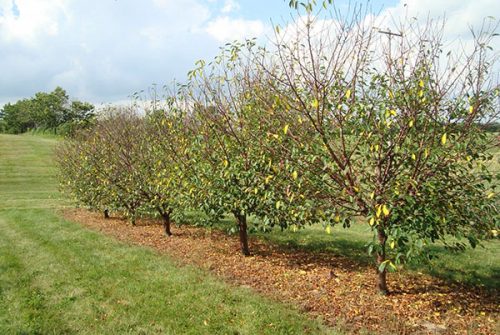

Cherry coccomycosis


Cherry moniliosis
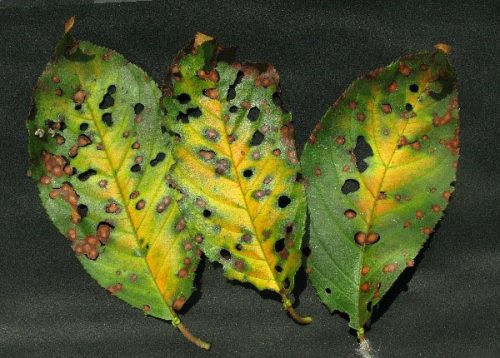

Cherry blossom hole
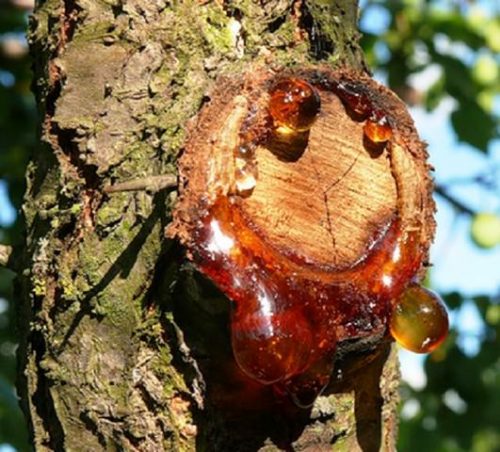

Cherry gum flow
Cherry Shokoladnitsa: reviews of those who planted and grew
Although the variety is fairly new, it is already popular with gardeners from different regions of Russia, who leave their feedback on the Shokoladnitsa cherry on the appropriate forum. Some of them are listed below:
Alina, 39 years old, Voronezh:
“They advised me to buy Cherry Shokoladnitsa in the nursery, where I turned in the spring for seedlings of fruit trees. I got a couple of seedlings of this cherry and in the end I was satisfied. They are growing on my site for the fifth season and have already given the first harvest last year. Collected about 10 kg from each tree. This year the trees have grown and bloomed so profusely that no branches could be seen behind the buds. Hope we get a good harvest. The ripe fruits were very tasty, they made jam from them and froze them. "
Svetlana, 48 years old, Penza:
“This cherry has been growing in my garden for about 10 years, I am pleased with the regular stable yield of the Shokoladnitsa variety - we annually collect about 14-16 kg from each tree. About 5 years ago, other varieties of cherries were planted nearby, which bloomed at the same time as Shokoladnitsa, and noted that the yield of Shokoladnitsa significantly increased. "
Tatyana, 50 years old, Ryazan:
“Various varieties of cherries have been growing in our garden for many years. And about 6 years ago, they decided to update the fruit trees and planted the Shokoladnitsa cherry. And now for a couple of seasons we have been harvesting crops from new trees. I liked the appearance and taste of ripe berries. And the harvested crop was used to prepare preparations for the winter - they made compotes and jam. "
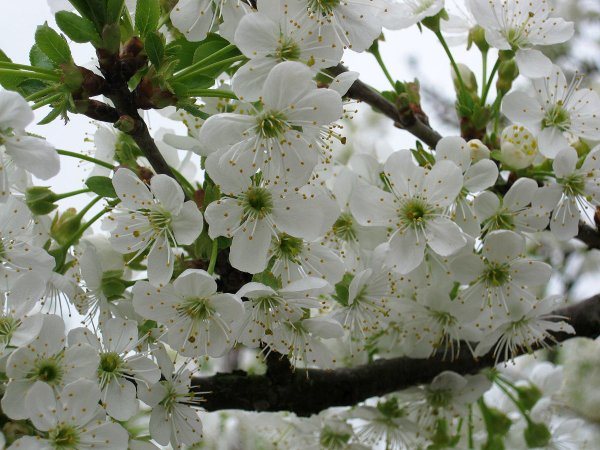

Olga, 39 years old, Samara:
“Our Shokoladnitsa has been growing for many years, its yield is beyond praise, and the taste of berries is simply wonderful. For several seasons, we not only close jams and compotes for the winter, but also sell part of the harvested crop. I constantly recommend this cherry variety to my friends and neighbors in the garden. "
mooch:
The chocolate girl is self-fertile, which is a plus for her, of course. But the taste of the cherries themselves is not perfect there, and even a big minus, IMHO, it is susceptible to the main cherry sores - coccomycosis and moniliosis.
Irena:
We consider the only disadvantage to be poor resistance to coccomycosis and moniliosis. This is the main disadvantage, since these diseases are now ubiquitous. And the yield of Shokoladnitsa is low - the berries are large, but there are few of them.
Cherry Shokoladnitsa is already well known to Russian gardeners as a frost-resistant and drought-resistant variety.
And the high yield of this fruit tree is another reason why it is worth planting Shokoladnitsa seedlings on your site.
Reviews of gardeners about cherry Shokoladnitsa
At the moment I have 2 Shokoladnitsa, 2 Vladimirki, 1 Turgenevka, 1 Molodezhnaya, 1 Michurinskaya. There is something to compare with. Although this is my first year, but the result for the 1st year is as follows: - The Shokoladnitsa bloomed most of all; - Most of all fruits were tied to Shokoladnitsa; - Most young shoots are on Shokoladnitsa; - Shokoladnitsa suffered the least from winter frosts. On others, 1-2 branches still froze. Of course, time will still show which variety is more resistant, but for now Shokoladnitsa is in the lead. Moreover, the area for growing cherries is not very attractive for me, the north of the Moscow region, the temperature is on average several degrees lower than in the middle and southern regions of the region. I saw some kind of map according to which my site is located on the border of the taiga region. I have them growing on a slight slope of the meadow from east to west. I think you still need to choose the right place for the cherry.
S-alek
I decided to plant cherries this year, came and bought seedlings. One is a chocolate maker and the other is a spunk. But the spanking was not in very good condition, and it seems to me that it withered. And the Shokoladnitsa sapling took root and turned green in the summer.
Vladimir Sergeevich
Shokoladnitsa is a small, compact tree covered with dark sweet cherries. My friend bought it, it bears fruit for the first year, I have not seen the berries yet, but the tree really looks more like a bush - it is very convenient to harvest.
anemona
I planted my cherries, bought as a "chocolate maker," in the spring of 2006. One tree did not overwinter, and the second one this year had several berries of quite decent taste.
Goryanka
Subject to the simple rules of planting and leaving the Cherry Shokoladnitsa every season will bring a rich harvest of berries with a delicious taste and undoubted benefits for the body.
Since childhood, I love nature and animals, so writing articles on these topics brings me great pleasure. Rate the article:
- 5
- 4
- 3
- 2
- 1
(9 votes, average: 4.1 out of 5)
Share with your friends!



